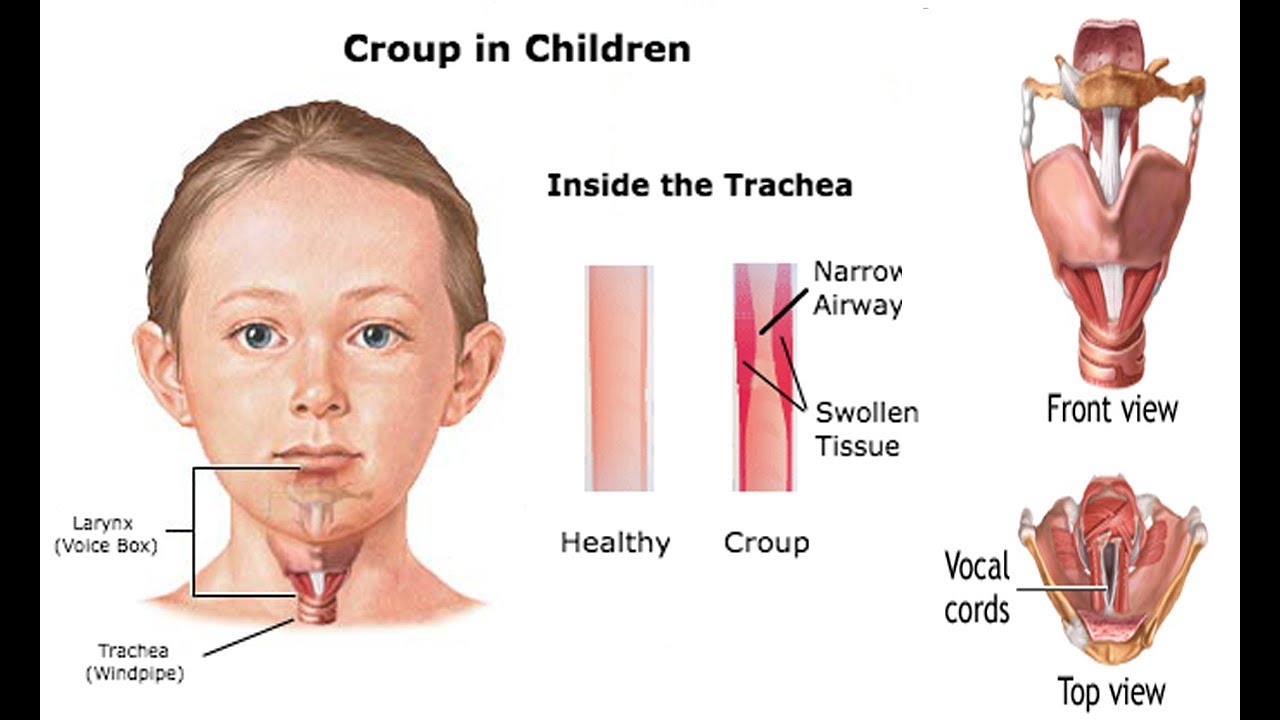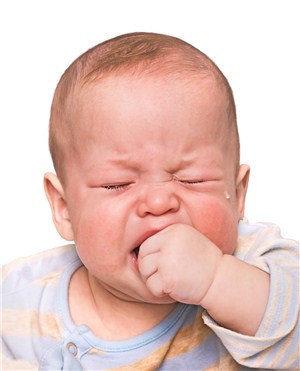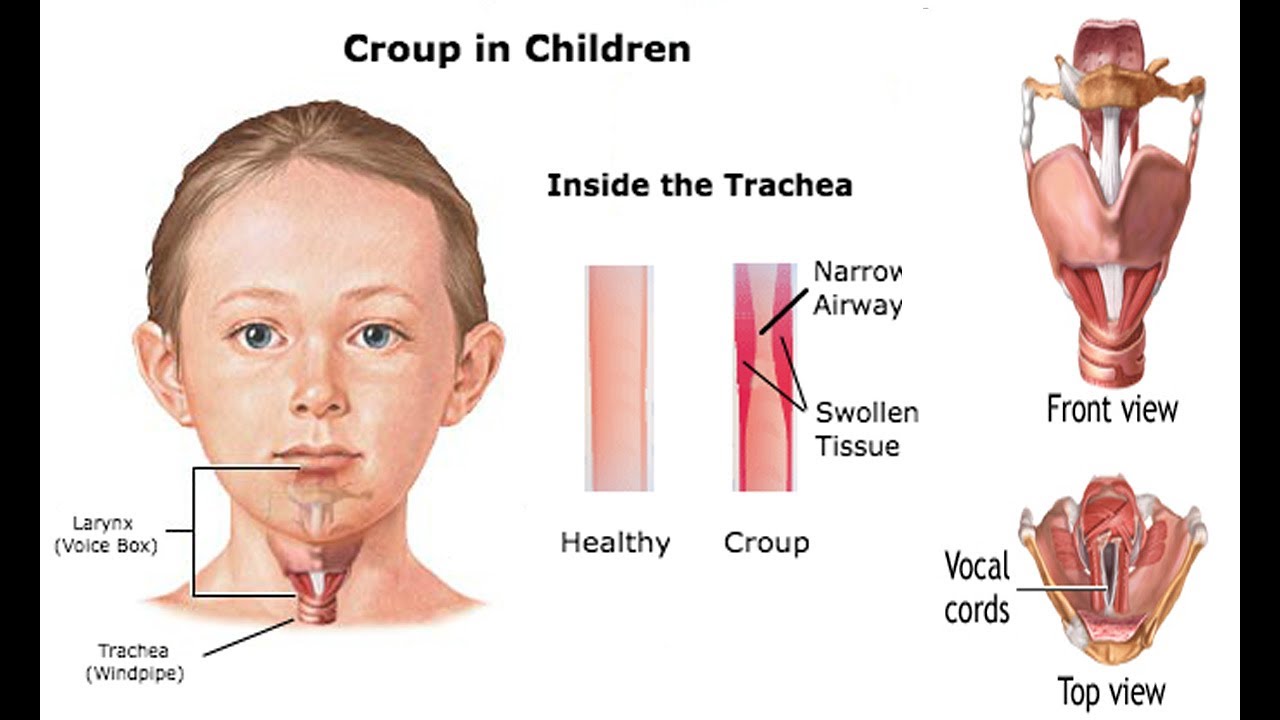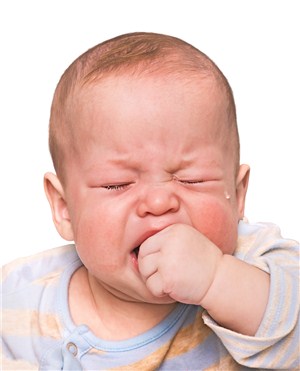Croup In Babies

Contents:
- What Is Croup?
- Causes Of Croup In Children
- Symptoms Croup In Toddlers
- What‘s To Be Done Before The Ambulance Arrives?
- Treatment Of Croup In Kids
- False Croup In Baby
What Is Croup?
Croup is a children’s airway pathology that occurs mostly in children under the age of four.
It is not by chance that it’s called croup. Translated from Latin it means “sharp sound”. The symptoms of croup are indeed: coughing that resembles a dog barking; a shrill whistling breath and wheezing in the lungs. Unfortunately croup mostly develops at night, when people are more prone to panic. The parents rarely manage to keep calm watching their baby in a state like this. That is no good. Because croup can hardly cause undesirable consequences and often goes away on its own without any treatment. Why children are more prone to this disease? The reason is the narrower airways, more elastic cartilages of the larynx and good blood supply in mucosa.
Causes Of Croup In Children
Croup develops due to the following mechanisms:
- swelling of the airway mucosa;
- inflammation of the epiglottis – the cartilage that blocks the windpipe when we swallow food or drink;
- spasm of the respiratory tract.
Mucosal edema normally occurs in children who have had respiratory problems and flu, children with allergies during exacerbation, deficiency of micronutrients in the blood, such as calcium. Diphtheria is a less topical reason which is included in the vaccination calendar. Inflammation of the epiglottis is accompanied by high fever, painful swallowing even in horizontal position. The inflammation can be originated either by viral or bacterial infections. Children playing with small objects can get a spasm of the respiratory tract.
A child can accidentally inhale a pea or a bead or just out of fun try putting them in a nostril.
Symptoms Croup In Toddlers

As we said above, the croup symptoms mostly develop at night. The child becomes restless.
The child has become restless.
Trying to inhale through narrowed Airways he/she sounds like a crowing cock, and exhalation is getting sharp, resembling a dog barking.
In these moments, parents must be extremely careful watching every change in the behavior and appearance of the child. Normally, under favorable circumstances a child can breathe in and out on his own.
High temperatures indicating at the infectious process, cyanosis in nasolabial triangle, nail beds; changes in child’s behavior – sluggishness, drowsiness, excessive excitement, are the reasons to immediately seek help and call an ambulance. These symptoms show that the body is poorly oxygenated.
What‘s To Be Done Before The Ambulance Arrives?
A properly provided first aid is of great importance. So, if your baby has had a disease attack corresponding to all the above symptoms:
- Call an ambulance.
- Give your child a pill of desensitizing drug diphenhydramine, tavegilum or suprastin (1/4 pills children under 3 years need, 1/2 pills – over 3 years).
- Get the windows wide open and keep the baby near one of them, wrapped in a blanket to protect him/her from drafts.
- Then make your kid a steam inhalation. To make this put in a pan of boiling water equal parts of Chamomile or Sage, soda and sunflower oil.
- Bring the mixture to a boil. Remove from heat and position the kid so he/she can inhale the vapors.
- If the child is very small, you can do the following: Do not remove the pan from the heat. Close the kitchen door and stand near the stove, holding the baby in your arms. Let the baby breathe the useful fumes.
- If you have a humidifier, turn it on. If not, hang up on the radiator wet towels and rags. The goal now is to make your apartment’s climate close to tropical.
- To make the kid feel better, you should have a warm and very humid atmosphere.
- Try to give the child warm drinks as much as possible. Warm milk mixed in half with warm still mineral water is quite suitable for this purpose. If the kid flatly rejects the “treats”, give any drink he/she finds acceptable. Your child is supposed to drink – better gradually, but as often as possible. Better to do it gradually, but as often as possible. This allows you to remove the larynx constriction.
- Get distracting procedure. Such as hot foot baths, water temperature should be about 42-45 degrees.
Distract the child: give a bright toy, show a cartoon. It is very important now to keep both you and the baby calm. Being that way makes you act reasonably and the kid – not to aggravate the situation. Excitement and fear are against the kid.
Treatment Of Croup In Kids

You can turn on the air conditioning in cooling mode or humidifier in cool mist mode. It’s very good, if you have both to use them together. Such measures can completely remove the croup attack or reduce its symptoms significantly.
Call your doctor if the child is having breathing or swallowing trouble. The doctor may recommend calling for emergency medical help. If a child makes more than 60 breaths per minute, nail plate turning blue, seek immediate emergency medical care.
If your child is having croup – do not panic. Take the child in your arms and go to the bathroom. Close the door. Turn on the hot water in the shower. Stay in the bathroom for 5-10 minutes. A walk in the cold air has a great effect. Dress up the child warm and position him/her half-bent in a stroller or in your arms. In any case, do not put the baby on a flat surface in a horizontal position. Croup attack ends in an hour since the first symptoms appear. Should any symptom of croup emerge, call your doctor.
Drug therapy is indicated for the bacterial infection. Antibacterial drugs are rarely helpful. The most common are steroid medications improving the respiratory function. In some situations drinking warm liquids or frequent feeding by small portions are helpful as well.
False Croup In Baby

Whilst an adult needs a couple of three to recover from the ARI aka “common cold” with no much trouble (except snivels, malaise and cough), a child faces a serious disease. A group of diseases, to be more precise.
The danger is in various complications. False croup is considered to be the most dangerous one. False Croup is also named sharp constrictive laryngitis (FRA) or laryngotracheitis. It all depends on whether the affected zone is only the throat or larynx with trachea.
False Croup in children sometimes can occur again and again. Some children may develop larynx stenosis catching a slight cold, even in the lightest form of infection. The risk group includes highly emotional and excitable children, with allergic predispositions and exudative diathesis. Boys are more prone to false Croup than girls.
By the age of 6-8 croup shall disappear — the child simply “outgrows” them having the larynx clearance become wider, making the swelling not dangerous to life.
False croup symptoms in children may appear either suddenly (even in completely healthy children), or gradually in a couple of days following the ARI.
The larynx swells primarily at night, but can also swell at daytime or during an afternoon nap. Sometimes false croup in children can be confused with suffocation caused by a foreign object, but in this case, the child is unable to speak. When false Croup in children it is saved, the voice becomes squeaky and in a Husky.
Children having false croup can talk, the voice becomes hoarse and squeaky.
False croup in children can be also confused with asthma attacks, one should know that the false croup inhale is hindered producing a noisy sound and exhale is almost inaudible. The whole situation looks pretty frightening to the parents; the baby seems to be breathless, just trying to retract the air. Bronchial asthma is quite the opposite: inhale is completely free, and exhale is hindered, making whistling sounds.